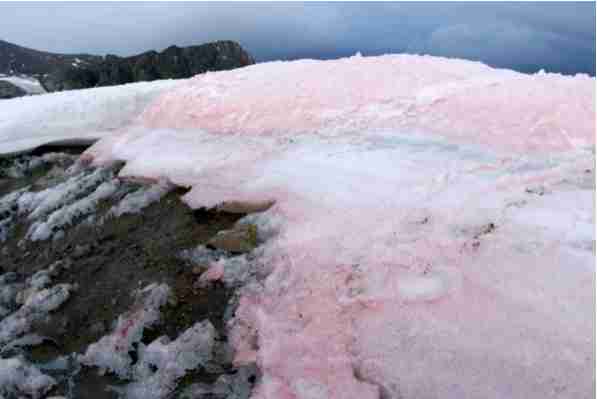导读:新研究发现,雪藻和其他喜冷物种之间发生化学反应导致极地的雪呈现红色,加剧气候变化。

Pink snow was a high-latitude curiosity described by Arctic explorers.
粉红色的雪被北极探险家描述为高纬度的奇观。
Biologists know now that the red hue is the result of a chemical reaction within the algae Chlamydomonas nivalis and other cold-loving species.
生物学家现在知道,雪呈现红色的色调是极地雪藻和其他喜冷物种之间发生化学反应的结果。
These algae are normally green, but as they start to suck up ultraviolet rays, they turn red.
这些藻类通常是绿色的,但当它们开始吸收紫外线就会变成红色。
The unusual phenomenon is also found in high altitudes, and sometimes called watermelon snow or blood snow.
这种不寻常的现象在高海拔地区也时候发生,被称为西瓜雪或雪血。
According to a new study, the algae cause Arctic melts, which are already happening at an unprecedented pace because of climate change, to worsen.
根据一项新研究显示,由于气候变化,北极冰川以前所未有的速度在消融,而藻类更是加剧了这个状况。
In their paper published Wednesday in the journal Nature Communications, the researchers examined 40 red-snow samples, representing 16 glaciers and snowfields from four Arctic countries: Greenland, Norway, Sweden and Iceland.
周三发表在《自然传播》期刊上的论文显示,研究人员检测了40种红雪样本,这些样本代表了格陵兰,挪威,瑞典和冰岛这四个国家的16个北极冰川和雪原。
The red algae darkens the snow, they found, causing it to melt faster than its white counterpart.
他们发现,红藻让雪变暗,导致其比白色的雪融化得更快。
Specifically, the European scientists measured the red snow’s albedo, the proportion of light reflected from a surface.
具体而言,欧洲的科学家们测量到的红雪的反照率,即表面反射光的比重。
It is a property of color: Dark objects, by definition, absorb a higher percentage of incoming light.Because light is energy, objects that take in more light become hotter. Conversely, lighter-colored objects reflect more energy and stay cooler.
这是色彩的特性:根据定义,暗的物体吸收入射光的比例更高。由于光线是能量,吸收光线更多的物体会变得更热。相反,浅色的物体反射更多的能量并保持凉爽。
The presence of red algae, on average, decreased albedo by 13 percent over the duration of the melting season.
红藻的出现,平均来讲,在融雪期降低了13%的反照率。
“Our results point out that the ‘bio-albedo’ effect is important and has to be considered in future climate models,” Lutz said in a statement.
“我们的结果显示‘生物反照率’效应很重要,必需在未来的气候模型中被考虑进去,”Lutz在一份声明中说。
The researchers note that current climate-change models account for details such as black carbon from forest fires and Saharan dust. The scientists suggest algae, too, needs to be considered.
研究人员认识到目前的气候变化模型考虑了比如来自森林火灾或撒哈拉沙尘的黑碳。但科学家建议,藻类也应该被考虑进去。
Exactly how large or small a role algae plays in melting glaciers is unclear, and the scientists plan to study it in more depth.
藻类到底对冰川融化有多大影响还不清楚,科学家计划对此深入研究。
But the geobiologists are concerned that the decrease in albedo may act like a positive feedback loop.
但地缘生物学家担心,反照率的下降可能像一个正反馈循环。
As more algae bloom, more snow thaws — and, nourished by the unfrozen water, even more of the microorganisms are able to grow.
当更多的藻类生长,就会有更多的雪被解冻——而由于冰雪融水的滋养,将会有更多的微生物生长。







